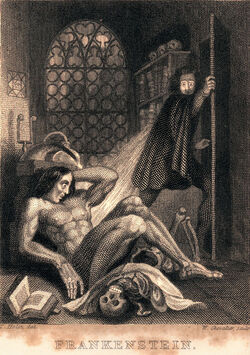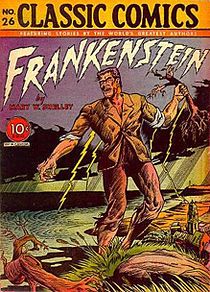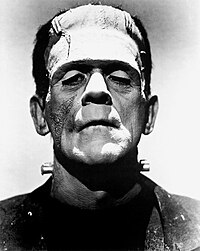
Illustration from an 1831 edition of Frankenstein.
Frankenstein, originally published as Frankenstein; or The Modern Prometheus, is a novel by the British author Mary Shelley. It was first published anonymously on January 1, 1818. May Shelley's name appears on the second edition of the novel, published in two volumes on August 11, 1822. A revised edition in one volume was first published on October 31, 1831. It is that version that is most widely read today.
The earliest version of the story that would later be revised, expanded and published as Frankenstein was written in June 1816 as part of a ghost story writing contest involving Mary Shelley, her future husband Percy Bysshe Shelley, Lord Byron and John William Polidori. As part of the same contest, Lord Byron attempted to write a story about a man who returns from the dead. It was published without Byron's permission in 1819 as "A Fragment".On the basis of Polidori's unfinished tale, Polidori wrote the short story "The Vampyre", considered to be the first work of modern vampire fiction.
The two main characters in Frankenstein are the young scientist Victor Frankenstein and the nameless monster that he creates using parts from several different human corpses.
Frankenstein is considered a classic of the horror genre and is also considered by some scholars to be the first science fiction story.
There have been numerous adaptations of the novel to other media. Among the most highly regarded of those adaptations are the 1931 American film Frankenstein starring Colin Clive and Boris Karloff and the 1957 British film The Curse of Frankenstein starring Peter Cushing and Christopher Lee.
Plot[]
The novel opens with letters and a journal written by Robert Walton, a British explorer on a ship sailing to the North Pole. Walton describes seeing a large man passing on a dog sled and then takes another man, who is in distress, on board his ship. The man says that he is Victor Frankenstein from Geneva and tells his story.

illustration by an unknown artist from a 1922 American edition of Frankenstein.
As a young student of biology and chemistry at the University of Ingolstadt, Frankenstein becomes fascinated by the secrets of life. He takes parts from various different corpses, puts them together in the shape of a man and uses his scientific knowledge to bring his creation to life. However, after the creature comes to life, Frankenstein finds it repulsive, describing it as a monster, and runs away from it.
Frankenstein becomes seriously ill for four months following the creation of the monster. During that time, the monster tries to make its own way in the world but is always met with fear and rejection because of its ugliness. Eventually, the monster hides near the home of a French family. The monster learns to speak and read from the family's books and hopes to befriend the blind grandfather. When the French family reject it too the monster becomes angry and violent.

Classic Comics issue #28 from December 1946 features an adaptation of Mary Shelley's Frankenstein.
The monster makes its way to the Frankenstein family home in Geneva and kills Frankenstein's younger brother William. The monster meets up with its creator and demands that Frankenstein make a female monster to be its mate. The monster says that it will leave with its mate to live in the deepest jungles of South America and never bother anybody else again. The monster threatens to come to Frankenstein on his wedding night if he does not create a mate.
Frankenstein begins to create a mate for the monster but destroys it. The monster keeps its promise to be with Frankenstein on his wedding night and kills his wife Elizabeth. Victor Frankenstein pursues the monster, seeking revenge. The two move steadily north, until they reach the Arctic.
After telling his story, Victor Frankenstein dies. The monster comes on board Robert Walton's ship. It appears to be upset by Frankenstein's death and declares its intention to take its own life.
Adaptations[]

1823 depiction of Thomas Potter Cooke as the monster in the play Presumption; or, the Fate of Frankenstein.

Charles Ogle appears as the monster in this advertisement for the 1910 silent movie version of Frankenstein.
Frankenstein has provided the inspiration for stage plays, radio dramas, animated cartoons, comic books, television specials, television series and movies.
The first stage play based on the novel, Presumption: or, the Fate of Frankenstein by the British playwright Richard Brinsley Peake, was first performed at the English Opera House in London on July 28, 1823. It was the only adaptation of Frankenstein to be produced during Mary Shelley's lifetime. Mary Shelley herself attended a performance of it on August 29, 1823. She later wrote of the play, "The story is not well managed", although she was impressed by the performance of Thomas Potter Cooke as the nameless monster. The play is notable for being the first work in which when the monster comes to life, Frankenstein exclaims, "It lives!" The line is not in Mary Shelley's novel. It is also notable for including a character who is not in the novel, Fritz, Frankenstein's servile assistant, the original version of a character who has come to be known in popular culture as Igor.
The first screen adaptation of Frankenstein was produced by Thomas Edison's film company in 1910, starring Charles Ogle as the monster. The short film shows Victor Frankenstein creating the monster from chemicals in a cauldron. The monster is presented as a creation of the negative side of Frankenstein's personality. When Frankenstein falls in love the monster begins to fade away and eventually disappears.
In 1931 Universal Pictures released Frankenstein, directed by James Whale and starring Colin Clive as the scientist Henry Frankenstein (as he is called in the film) and Boris Karloff as the monster. Seven sequels followed; The Bride of Frankenstein (1935), Son of Frankenstein (1939), The Ghost of Frankenstein (1940), Frankenstein Meets the Wolfman (1943) House of Frankenstein (1944), House of Dracula (1945) and the comedy Abbott and Costello Meet Frankenstein (1948). The movies helped to contribute to the popular misconception that "Frankenstein" is the name of the monster. Few of the movies feature a Victor Frankenstein-like creator figure but all of them feature the monster, always the same monster even though it was played by different actors.

Boris Karloff as Frankenstein's monster in the 1935 film Bride of Frankenstein.
In 1957 Britain's Hammer Film Productions produced The Curse of Frankenstein, directed by Terence Fisher, starring Peter Cushing as Baron Victor Von Frankenstein (as he is called in the film) and Christopher Lee as the creature. Five sequels followed: The Revenge of Frankenstein (1958), The Evil of Frankenstein (1963), Frankenstein Created Woman (1967), Frankenstein Must Be Destroyed (1969) and Frankenstein and the Monster from Hell (1974). Baron Victor Von Frankenstein is the main character in all of those movies, creating a different monster in each one. Hammer Films also produced the 1970 movie The Horror of Frankenstein starring Ralph Bates as Baron Frankenstein and David Prowse as the monster, an unsuccessful attempt to restart the franchise with a younger cast.
The 1994 American-Japanese film Mary Shelley's Frankenstein, directed by Kenneth Branagh, who also stars as Victor Frankenstein, and starring Robert De Niro as the monster, is, as the title suggests, intended to be a more faithful adaptation of the novel than any film version produced before.
Recent screen adaptations of Frankenstein include the films Frankenstein: Day of the Beast (USA 2011), I, Frankenstein (Australia/USA 2014) and Victor Frankenstein (USA 2015), the British TV series The Frankenstein Chronicles that originally aired on the ITV network between November 11, 2015 and December 6, 2017 and the American TV series Second Chance that originally aired on Fox between December 25, 2015 and March 25, 2016.
See also[]
- Video of Thomas Edison's 1910 Frankenstein, the first screen adaptation of the novel
- Trailer for the 1931 film Frankenstein
- Trailer for the 1935 film The Bride of Frankenstein
External links[]
- Versions of Mary W. Shelley's Frankenstein on Wikisource.
- Quotations from Frankenstein on Wikiquote.
- Frankenstein travel guide on Wikivoyage.
- Free public domain audiobook of Frankenstein from LibriVox.
- Frankenstein on the SparkNotes website.
- Frankenstein GCSE study guide from BBC Bitesize.
- Frankenstein Wiki.
- There are articles about Victor Frankenstein and Frankenstein's monster on the Halloween Wiki.
